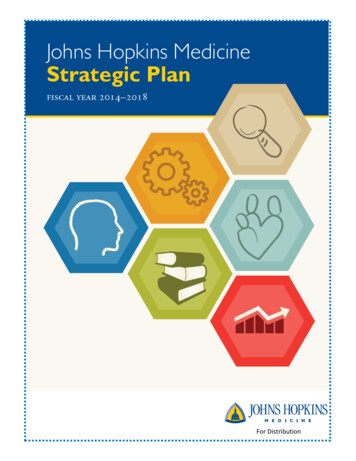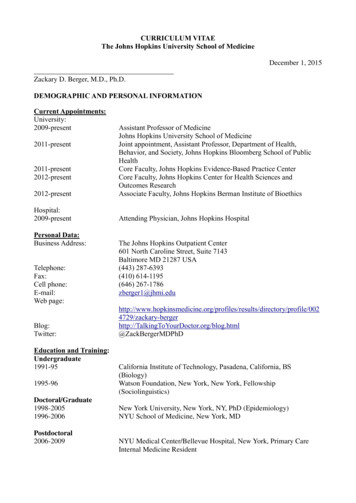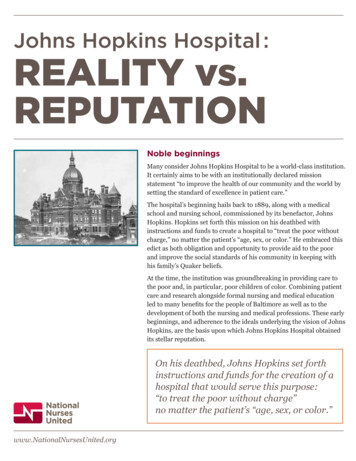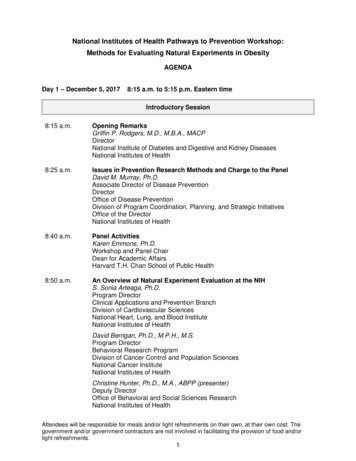
Transcription
For Distribution
Johns Hopkins Medicine Strategic PlanTable of ContentsPage 1
Johns Hopkins Medicine Strategic PlanFiscal Year 2014 – 2018Privileged & ConfidentialVersion 1: June 2013Johns Hopkins Medicine Strategic PlanThe Johns Hopkins Medicine (JHM) Strategic Plan for fiscal years 2014-2018 will guide business strategies anddecisions for the enterprise in a rapidly changing health care environment. Of prime concern is our responseto health care reform, which encompasses both the direct effects of the Affordable Care Act and broaderchanges stimulated by federal and state budget constraints, including increased need for accountability,transparency and controlling costs. These changes present challenges and opportunities for all parts of thenation’s health care system, but none more so than academic medical systems, which will need to maintainstability and create responsive new structures while honoring their mission of patient care, research andeducation. This must be accomplished even as the emphasis on quality and affordability increases, patientexpectations and a consumer mentality toward health care grow, federal and state funding for research andeducation decreases, and as competition for market share and brand recognition intensifies.To remain an innovative leader in our field, Johns Hopkins Medicine will need to chart a course in theevolution of health care that will uphold the tripartite mission and be used as a model throughout theindustry, just as we have consistently done over the course of our history. This plan is the roadmap for thatpath forward. Paul Rothman, M.D., the dean of the medical faculty and CEO of Johns Hopkins Medicine, hasidentified the JHM Strategic Plan as one of the most critical activities in the first year of his tenure and has ledthe multidisciplinary development process.Structure of the PlanThe JHM Strategic Plan comprises six priorities—critical areas of focus for the success and sustainability ofJHM. The strategic priorities and overall structure of the plan were developed during an 18-month process ledby the Strategic Plan Executive Council, a diverse, multidisciplinary group of faculty and staff leadersrepresenting all member organizations and a host of functions throughout JHM. The strategic priorities are: PEOPLE: Attract, Engage, Retain and Develop the World’s Best People BIOMEDICAL DISCOVERY: Become the Exemplary Model for Biomedical Research by Advancing andIntegrating Discovery, Innovation, Translation and Dissemination PATIENT AND FAMILY CENTERED CARE: Be the National Leader in the Safety, Science, Teaching andProvision of Patient and Family Centered CarePage 2
Johns Hopkins Medicine Strategic PlanFiscal Year 2014 – 2018Privileged & ConfidentialVersion 1: June 2013 EDUCATION: Lead the World in the Education and Training of Physicians and Biomedical Scientists INTEGRATION: Become the Model for an Academically Based, Integrated Health Care Delivery andFinancing System PERFORMANCE: Create Sustainable Financial Success and Implement Continuous PerformanceImprovementThe strategic priorities were selected based on the assumption that the people of JHM are our mostvaluable asset and that consistent improvement of financial performance is imperative for sustainabilityand growth. These two notions yielded the People and Performance priorities. The remaining prioritiesrepresent the vision and tripartite mission of JHM: Biomedical Discovery, Education, Patient and FamilyCentered Care, and Integration. The latter two represent the ends of the clinical care spectrum: individualcare and population health. Embedded in each Strategic Priority is an understanding and commitment tobe a leader in ethical issues related to that Priority.Each strategic priority is accompanied by explicit metrics to evaluate progress and to set clear expectedoutcomes, along with goals, strategies and tactics to create a specific path to accomplishing these aims.Leaders have been identified to spearhead and be accountable for the development of each strategicpriority and to oversee planning, implementation and ongoing monitoring. The goals, strategies, andtactics within the strategic plan will be reflected and aligned with the JHM 10 Year Plan, drive budgetpriorities and resource allocation, and respond to challenges identified by Enterprise Risk Management.A New VisionThe exceptional creativity, curiosity and energy that the people of JHM bring to solving problems is thesame today as it was in our earliest days. The JHM Strategic Plan outlines our trajectory to once again riseto the occasion and innovate in an era of tremendous change in health care. With the plan as ourfoundation, we will continue to be at the forefront of medicine, research and education, and we willremain the most trusted global brand in medicine. Our new vision statement both summarizes this andspeaks to the power and potential of JHM:Johns Hopkins Medicine pushes the boundaries of discovery, transforms health care, advances medicaleducation and creates hope for humanity.Together, we will deliver the promise of medicine.Page 3
PeopleAttract, Engage, Retain and Develop the World’s Best PeopleAccountable Leaders: Janice ClementsPamela PaulkGoal 1. Invest in and reward healthy lifestyles, professional development, mentoring and advancement ofJHM’s people.Strategiesa. Actively support a healthy workforce throughout JHMb. Create transparent pathways for contribution to the mission, support by peers and mentors, engagementand advancementc. Identify development plans for employees and identify succession planning and retention strategies forthe highly performing staff and facultyd. Enhance support for junior facultyGoal 2. Create a culture where diversity, inclusion, civility, collegiality and professionalism are championed,valued and exhibited through actions, incentives and accountability.Strategiesa. Improve women and minority representation throughout the organizationb. Promote diversity and inclusion by employing more formal search processes.c. Harmonize codes of conduct by creating a JHM-wide policy that can be enforced and is aligned across theUniversity and Health Systemd. Identify succession planning and retention strategies that will retain junior faculty and key staff (with anemphasis on women and underrepresented minorities) as well as exit strategies for senior faculty and staffwhen appropriatee. Create expectation that faculty, trainees and staff contribute to community engagement programs andorganizationsGoal 3. Ensure that fair and easily understood rewards are implemented, particularly compensation thatreflects the scope of work, quality and leadership responsibilities.Strategiesa. Ensure that people at JHM experience an environment that values their contributions, rewards theirsuccesses and provides valuable feedback on their performanceGoal 4. Recruit, engage, retain and invest in innovative leaders and a flexible workforce that promotes crosseducation and development of interdisciplinary teams across all JHM.Strategiesa. Encourage innovation in position descriptions for staff, faculty and physicians to increase productivity, andprovide non-financial incentives for innovation, flexibility and increased patient accessb. Provide support to department and division directors and managers, and hold them accountable for theperformance and engagement of their employees and facultyc. Partner with the Armstrong Institute to understand requirements and provide resources for individualsand teams who are engaged in quality and safetyGoal 5. Create pathways to recruit, advance and reward excellent clinicians throughout JHM.Page 4People
Johns Hopkins Medicine Strategic PlanFiscal Year 2014 – 2018Privileged & ConfidentialVersion 1: June 2013Strategiesa. Implement SuccessFactors, business software that aids in organizational alignment, helps optimizepeople’s performance and provides insights into the workforceb. Identify recruitment and workforce needsPage 5People
BiomedicalDiscoveryTo Become the Exemplary Model for Biomedical Research by Advancing and IntegratingDiscovery, Innovation, Translation and DisseminationAccountable Leaders: Landon KingDan FordGoal 1. Create a new research ecosystem that uses resources across JHM to accelerate collaboration,innovation, quality and impact of all research from curiosity-driven basic discovery to implementationsciences.Strategiesa. Establish an organizational structure to oversee execution of research throughout JHMb. Expand resources to help researchers partner with new funding organizations and broaden their fundingportfolios beyond the NIHc. Develop, manage and support a panel of basic, clinical and administrative research core services that areunsurpassed in their ability to enable faculty discovery, innovation, translation and disseminationd. Develop organizational structures and financial models that foster greater collaboration in researchthroughout JHM and the University, and enhance interactions between basic and clinical investigators,clinical providers and patients, thereby improving the quality of both research and clinical caree. Increase the visibility of JHM research to enhance efforts in education, advocacy and funding to increasethe impact of our research mission.Goal 2. Become a leading institution for data-intensive science, developing new models, methodologies andresources for collection, management and analysis of large scientific, clinical and administrative datasetsStrategiesa. Develop the computational sciences and health care informatics faculty and workforce to empowerresearch faculty pursuing data-intensive science. Synergize with University’s inHealth strategic initiativesb. Develop sufficient computational capacity to promote growth of data-intensive sciencesc. Establish service core functions that will serve the data-intensive needs of JHM investigatorsd. Establish mechanisms and policies to govern and facilitate access to and analysis of large scientific, clinicaland administrative datasetsGoal 3. Create a transformative JHM fund dedicated to “Advancing the Frontiers of Discovery,” to be usedexclusively in support of the research missionStrategiesa. Designate investment in scientific discovery as an enterprise-wide priority for JHMb. Initiate Discovery Fundc. Develop a governance model for oversight and administration of the fund, including guidelines forprioritization of investment, access and useGoal 4. Establish a model to support and sustain research faculty across their entire careers and in a rapidlychanging funding environment.Strategiesa. Enhance support for junior facultyPage 6Biomedical Discovery
Johns Hopkins Medicine Strategic PlanFiscal Year 2014 – 2018Privileged & ConfidentialVersion 1: June 2013b. Enhance support for mid-level and senior facultyc. Establish uniform mechanisms for incentivizing research activities and research-related committee servicePage 7Biomedical Discovery
Patient and FamilyCentered CareBe the National Leader in the Safety, Science, Teaching and Provision of Patient and FamilyCentered CareAccountable Leaders: Bill BaumgartnerJudy ReitzPeter PronovostGene GreenGoal 1. Promote a culture that embraces, expects, and rewards the delivery of patient and family centeredcare.Strategiesa. Establish the delivery of patient and family centered care as a central tenet for which leadership and staffat all levels across JHM will be held accountableb. Recruit, develop, train, and retain an engaged and service-oriented work forcec. Measure performance related to the provision of patient and family centered care, report findings and actupon results to foster ongoing improvementGoal 2. Partner with patients, families and others to eliminate preventable harm and optimize patientoutcomes and experience while reducing healthcare costs.Strategiesa. Partner with the Armstrong Institute to promote the science of and conduct research in patient and familycentered careb. Promote clinical excellence as a component for academic promotionc. Implement the transdisciplinary care coordination bundle across all inpatient units to optimize transitionsin the post-acute period, to produce quality outcomes (e.g., reduced preventable readmissions,complications, adverse events, and unwarranted variations in care) and to enhance the patient and familyexperienceGoal 3. Engage patients and families in shared organizational and clinical decision-making.Strategiesa. Implement diverse, active, and engaged patient and family advisory committees at all memberorganizations by the end of fiscal year 2014Page 8Patient and Family Centered Care
EducationLead the World in the Education and Training of Physicians and Biomedical ScientistsAccountable Leaders: Roy ZiegelsteinDavid HellmannGoal 1. Build an effective culture for learning and education across all JHM member organizations, leveragethe University‘s infrastructure, and facilitate interprofessional educational programs.Strategiesa. Grow and develop interprofessional education teams involving partners in nursing, pharmacy, publichealth, etc.b. Develop strategies for faculty development in interprofessional educationc. Increase space for simulation-based training and programsd. Develop a monthly conjoint conference for medical, graduate and postdoctoral students.e. Work with the Development Office to increase philanthropic support for interprofessional educationGoal 2. Ensure that medical and biomedical education at Johns Hopkins is transformative as reflected bycurricula that emphasize cutting-edge science, novel treatments, wise use of technology, and avoidance ofunnecessary medical tests and procedures.Strategiesa. Identify the most significant diagnostic procedures, medical treatments and scientific discoveries in thepast three yearsb. Review our graduate, medical student, residency and fellowship programs to ensure that these recentadvances are part of their curricula and if not, that curricula are modified and that faculty are trained todeliver this contentc. Have each residency program identify 1 commonly used unnecessary or wasteful medical test orprocedureGoal 3. Ensure that medical and biomedical education at Johns Hopkins is transformative as reflected bymethods of instruction that are creative and innovative, and that take advantage of all that emerges from theJohns Hopkins Science of Learning Institute.Strategiesa. Work with the Johns Hopkins Science of Learning Institute to identify creative and innovative methods ofteaching medical and graduate studentsb. Create teaching-skills development programs that help faculty implement these methods whenappropriatec. Support the continued development of the Center for Innovation in Graduate Biomedical Education toserve as an incubator for the development and dissemination of new paradigms for graduate biomedicaleducationGoal 4. Develop a robust system to monitor the progress and accomplishments of those enrolled in, and thosewho are graduated from, our undergraduate, graduate, residency and postdoctoral programs to ensure thatindividuals who receive a Johns Hopkins SOM education are among the most creative and outstanding leadersin medicine and biomedical science in the 21st century.StrategiesPage 9Education
Johns Hopkins Medicine Strategic PlanFiscal Year 2014 – 2018Privileged & ConfidentialVersion 1: June 2013a. Obtain funding for, and then staff, an Office of Assessment and Evaluation that will maintain, track,analyze and disseminate data regarding student performance; develop electronic portfolios for alllearners; develop and maintain a database for graduates; obtain and analyze data for ongoing programevaluation; and maintain information on graduates of our programsGoal 5. Create a model for global dissemination of Johns Hopkins programs in medical and graduate medicaleducation, to include distance learning via online educational programs.Strategiesa. Clarify the role of the director of the Swami Institute for International Medical Education (SIIME) andensure that the director works closely with the dean/CEO of PUGSOM to continue to develop the PUGSOMclassroom and clinical training experiences, and to maintain collaborative learning opportunities betweenthe two campusesb. Develop a centralized system and policies and procedures that support the development of distancelearning programsc. Secure funding from donors or partner with companies to support the development and implementationof technology-enhanced educationPage 10Education
IntegrationBecome the Model for an Academically Based, IntegratedHealth Care Delivery and Financing SystemAccountable Leaders: Patty BrownBrian GragnolatiSteven KravetGoal 1. Achieve global recognition by designing and implementing an innovative model of care delivery andfinancing aimed at improving the health of populations, enhancing quality and reducing costs.Strategiesa. Define the regional, national and international geographic footprint, and define the optimal number of“aligned patients” required to support the tripartite mission and remain financially strongb. Review existing and emerging markets and JHM’s current and proposed participationc. Inventory JHM and University clinical assets, partnerships and infrastructure to identify gaps, limitationsand redundancies and identify viable approaches, models and vehicles to enhance the delivery andfinancing systemd. Define and prioritize strategy to incorporate JHM’s work on individualized, personalized medicine intodelivery system reform and developmentGoal 2. Over a five-year period, fully implement the required elements of the newly defined, integrated healthcare delivery and financing system.Strategiesa. Build or partner to achieve the necessary clinical capacity, anchored by a strong primary care network, toensure access to high-quality aligned providers and facilities within the defined geographic footprintb. Grow the number of people whose health we are helping to manage by JHM by growing JHHC and itsinsurance productsc. Develop the necessary infrastructure to prepare for emerging payment modelsd. Adapt research and teaching strategies to take advantage of an expanded and different delivery systeme. Implement various approaches, models and vehicles to achieve goals of clinical and financial integrationwhile maintaining systems that support a fee-for-service payment systemPage 11Integration
PerformanceCreate Sustainable Financial Success and Implement Continuous Performance ImprovementAccountable Leaders: Rich GrossiRon WerthmanGoal 1. Ensure that all financial operations, performance indicators and results support the strategic priorities,as well as the individual entity requirements.Strategiesa. Maintain a level of performance equivalent to an AA- or better credit rating and additional measures asappropriateb. Create a structure to prioritize capital and other investments across the systemc. Create a mechanism to capture the value of community benefit and ensure that it supports strategic goals,and achieve compliance with community benefit standardsd. Create systems to reduce professional liability exposuree. Define strategy and resources to achieve high rankings in prioritized public ratings systems.f. Advance and measure JHM brand position to support strategic growthg. Proactively engage global, national, regional and local audiences through an innovative, cohesive, andsatisfactory online visitor experience.Goal 2. Identify new and expand existing sources of revenue and implement operating efficiencies consistentwith the tripartite mission and with a commitment to reducing health care costs.Strategiesa. Develop the plan and infrastructure for the 150-200M Performance Improvement Initiativeb. Successfully implement the 150-200M Performance Improvement Initiative, a JHM-wide financialimprovement plan to identify an additional 150-200M in profit marginGoal 3. Establish a transparent financial reporting system available to and understood by all JHMconstituencies.Strategiesa. Incorporate cross-enterprise systems that measure achievement of financial goals driven by standardizeddata and help to communicate results in a transparent formatb. Use singular end-to-end financial systems that can be accessed by the greater JHM communityc. Revise 10-year planning to incorporate system math and population managementPage 12Performance
Structure of the Plan The JHM Strategic Plan comprises six priorities—critical areas of focus for the success and sustainability of JHM. The strategic priorities and overall structure of the plan were developed during an 18-month process led by the Strategic Plan Executive Council, a diverse, multidisciplinary group of faculty and staff leaders











